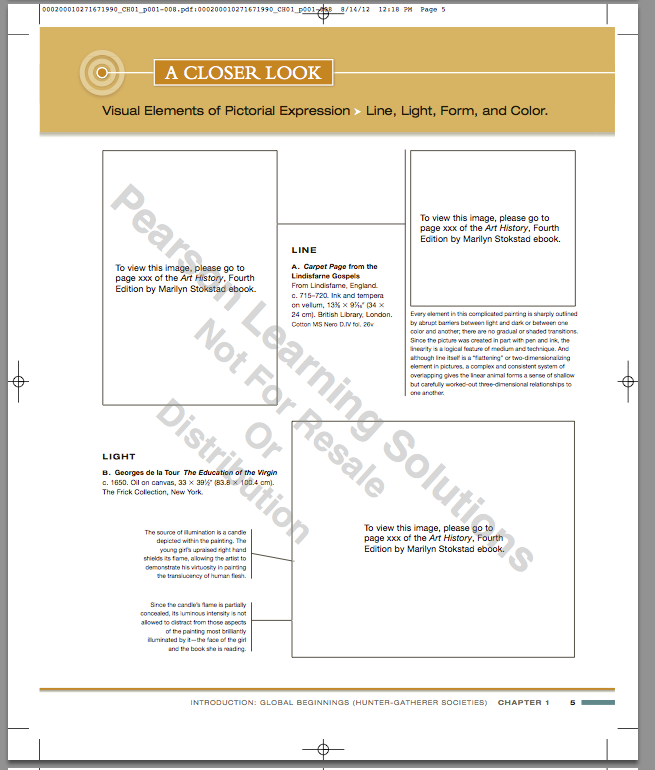There has been quite a bit of discussion about this textbook affair. A lot of people are stuck on the copyright issue. Yesterday I summarized my thoughts about it in a comment on the recent TechDirt article. Today I received a similar summary from a commenter named Vlad posting from Russia. I’ll post them both here.
First, my comment at TechDirt.
It turns out it’s not as simple as it seems at first. For the benefit of all, here are some things that have become clear to me this week.
Copyright isn’t where the expense lies, it’s Licensing.
If you want photos of public domain art works that are of high enough quality for print publication, you have a few choices.
1) You can send a photographer out to take photos of each work. Many will be in museums and will require negotiating a photography session with the museum. One reason is that the light used in high power flashes for this quality of photo has a high UV content and over time will contribute to deterioration of the work, so they limit access.
This is very expensive and time-consuming, but you will get high quality photos.
2) You can find a photographer or organization who has done #1 themselves or has bought the rights to license images from other photographers.
This will get you the quality photos, and save you some money.
3) You can try to source photos that have open and free licenses. While there are some organizations who are collecting such images (e.g. googleartproject.com, art.sy, and others), there is not a deep well of these resources, so your experience will result in a lot of searching and varied quality.
As you can see, #2 is optimal among these (possibly not exhaustive) choices.
When you want to get photos for your book, you pay a license fee to the person who can provide you with the high-quality source material. They calculate it based on a number of factors, one of which is the quality of the final images – i.e. it’s cheaper to license a bunch of images to be presented in thumbnail or screen form than in full resolution.
If you print and sell 10,000 copies of your book, the cost component of the licensing is distributed much more thinly than if you have a limited run of 500 books. You have a choice of whether to present pictures in full, thumbnail, or online, or a combination. The choices made in this case resulted in a product that did not meet the needs of the audience (understated, I know, but that’s the bottom line).
What this all comes down to is that once the logistics of producing a book are considered, it’s apparent that there is no one entity in the chain demanding excessive profits. It’s just the economics of a high quality small print run in play here, and then the design decisions that came out of that.
So far the response of the school and the publisher has been very positive and I’m optimistic that a much better solution will come out of this episode. Open dialogue has been spawned and the wider issues of copyright, licensing and the spiralling cost of a university education have been subjected to very public review and criticism.
Thanks to the students who started the petition, and TechDirt who provided a platform for wide recognition, this story promises to have as happy an ending as one could hope for.
And Vlad’s comment:
Let me explain this story in plain words and by numbers.
1. All pre-1800 visual materials (paintings etc) are copyright free. Reproduce them all you want.
2. Quality digital images of these materials are not free and even not cheap, as producing them is really not cheap (you actually need to travel to dozens or hundreds of museums and pay them for using commercial photo equipment there, they charge for that).
3. A certain publisher has paid for gazillions of these images and printed three different textbooks. Their total retail price is 300 dollars. This value is the cost of printing, the price of images, the price of the text, the profit margin and so on — DIVIDED by the number of printed books.
4. A certain college professor realizes that his students need all three books to take the course. But 300 dollars is a lot, so he and the college look for a better solution.
5. They decide to publish a partial compilation of these three textbooks for a lower price and approach the original publisher. He does not mind and tells them the price of copyrights. It’s a resonable price, but when you DIVIDE it by the very small number of books the college needs, it’s 800 dollars per book. Not good.
6. They compromise: the compilation is printed without pictures, the pictures will be available for students online for free, all three original books with images will be available for students online for free — when they buy the compilation for 180 dollars. Instead of paying 300 dollars for the three books. Everybody is happy, everybody wins.
7. Except a small number of slacktivists. They are not happy, but luckily they don’t win either.
I’m sure you’ll note that I disagree with his assessment since the story continued somewhat beyond the reaction to a conclusion that suits many of the detractors, but that’s his opinion and I’m glad to have him express it.


